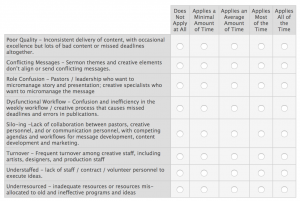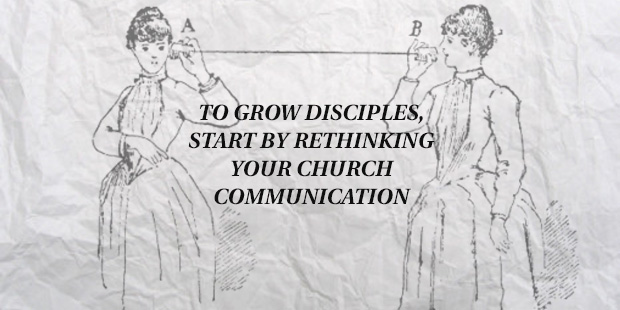
Three Best Practices for Building People who Invite People
At my church, communication and marketing is all about equipping people to represent the church in the community. This, and not advertising, is my best strategy to invite people and grow a church. It’s built in relationship, based in community, fits with the gospel and fits with best communication practices today.
WHAT IS YOUR CHURCH MARKETING STRATEGY?
A church member recently asked me about putting an ad on a billboard. It got me to thinking – what do I like and not like about this idea? This led to some clarification about our brand – what matters to us as a church, or as I have called it, what makes us burn. (If you’re trying to figure out your church’s brand, look here for a set of tips to help you explore.)
After 18 months of learning the community of St. Andrew, I realized that we have two brand distinctives as a church:
1. A STRONG COMMITMENT TO AND COMMUNITY OF RELATIONSHIPS
In most churches, a strong sense of relationship means a small community. While many large churches are perceived as being impersonal, St. Andrew senior pastor Robert Hasley’s long commitment to the people of St. Andrew has created as strong an association with relationships as you’ll find in any large church.
2. AN EXCELLENT OFFERING OF WEEKLY WORSHIP
At the same time, you’d be hard pressed to find a large congregation in north Texas that offers such high quality worship in both traditional and contemporary settings. While traditional worship at St. Andrew is long established, contemporary worship has caught the attention of many, as evidenced by its strong growth trajectory (our contemporary worship has averaged over 10% growth for two years straight, which puts it among the top churches in America.)
I like to talk about these two brand distinctives in a single phrase: Side by Side. In relationships with one another, we are one church, standing side by side, changing the world through the work of the Holy Spirit. In our matching, high quality traditional and contemporary worship styles, we stand side by side, offering a dual experience that is unique among regional churches.
EFFECTIVE COMMUNICATION IS ABOUT RELATIONSHIPS
While most marketing tries to build community, or “establish markets,” good churches already have a true community. Good communication in a local church builds on relationships.
According to Dallas-based large church research firm Leadership Network, 90% of church growth happens on the arm of a trusted friend. We have been seeing this in action at St.Andrew, where we are growing through organic spread of effective, word of mouth marketing from friend to friend and family to family.
That means the primary goal of church marketing isn’t to generate new “leads” but to galvanize and inspire the people who call St. Andrew home to invite their friends and neighbors. Churches that look to marketing to generate leads are usually not healthy, vibrant and growing.
Church marketing doesn’t drive relationships. Church marketing supports relationships.
THE HIGH BAR OF COLD CHURCH MARKETING.
The reason is that the bar for cold visits is simply too high in church now.
Consider: your brand has to be so comfortable with a prospective newcomer that they would feel no qualms about making the choice to visit. That means they must be comfortable with:
- the people who attend – do they look like people I’d like?
- the facility – does it look current or creepy?
- the brand – does the church seem friendly?
- the website – can I figure out what’s going on?
- the campus signage – can I figure out where to go?
- the communication within the church – what happens if I visit?
Once inside, the first word out of a greeter’s mouth may make or break it. Even if the visitor clears bars 1 – 5, often something happens in the lobby (narthex) or in the worship service that turns the visitor off, and they don’t return.
Instead, most people come and stay because of the second way – the invitation of the friend. Friends help newcomers contextualize, understand and minimize their fears.
Church marketing is about the power of personal recommendation.
INSTEAD, HELP YOUR PEOPLE INVITE PEOPLE.
Good church marketing helps to overcome the awkwardness a church community feels about discussing matters of religion and faith with those outside the walls of their church. It gives people specific handles to start and continue conversations.
As the life of faith is built on relationships, good church marketing serves as a form of strategic caring by facilitating new relationships and deepening existing ones. This is how church growth really works.
The world of business is gradually coming to the same realization. To quote marketer Seth Godin, we no longer live in an interruption economy but a permission economy. Effective communication today engages audiences, builds trust, and earns permission, rather than getting attention by sticking a foot in the door and yelling.
The beauty of St. Andrew is that we are already a church built on the power of personal recommendation. We are a church of relationships. We trust the word of a friend. Because of this, our primary goal isn’t to grab people cold, but to support and extend existing networks and organic opportunities. Our primary goal is to elevate the St. Andrew brand through the power of relationships.
3 MEASURES FOR HELPING YOUR PEOPLE INVITE PEOPLE.
In order for your people to feel comfortable inviting others, you need to make sure you’re delivering on a few basics. Rather than putting all of your attention into advertising, which is mostly a poor use of your resources, I’d suggest these three things:
1. DELIVER ON AN EXPERIENCE PROMISE.
If every fourth worship service is a clunker, with bad music or failing technology or a meandering message, your people won’t have trust that next week will be meaningful. Create a consistent excellent experience each week, so that your people feel comfortable inviting their friends.
2. DELIVER ON THE HOSPITALITY PROMISE.
Overcome the awkwardness people naturally feel when walking into a new church. Create a world-class hospitality environment, where people feel welcomed and that the church is a good “fit” for them.
3. EQUIP YOUR PEOPLE TO INVITE.
Don’t just expect people to do the work of inviting on their own. Give them resources and handles to help facilitate easy conversations. Help your people tell the story of your church community and create new and additional opportunities for invitation and hospitality.
We occasionally advertise, and we also do publicity work. But the measure of success of good marketing in your community isn’t by the cold calculus of leads but by the warmth and excitement your own people feel about your church. It is about their eagerness – not just willingness, but excitement – about sharing the power of their church experience with their co-workers, friends and family.
What efforts would you like to see your church implement to become better at inviting people?
Read more from Len.

Tags: Len Wilson, invite people

















